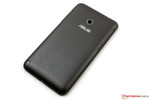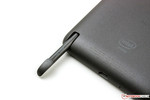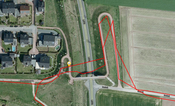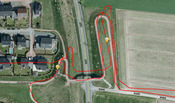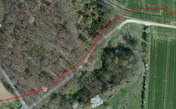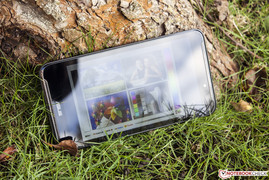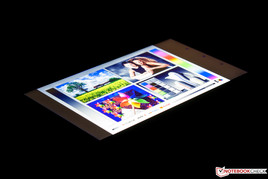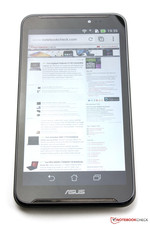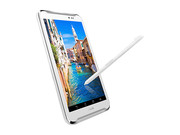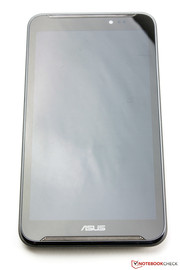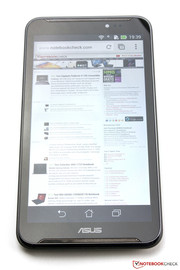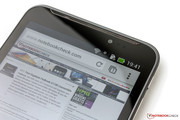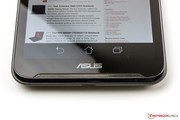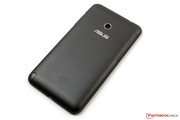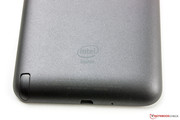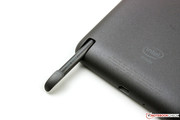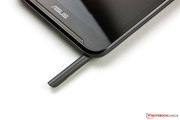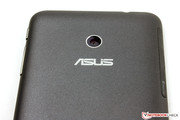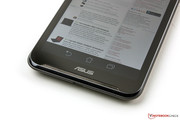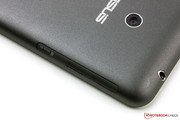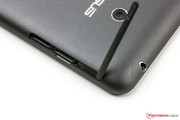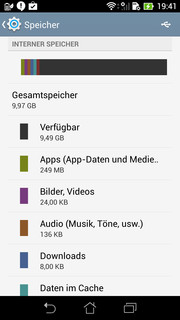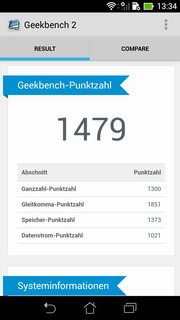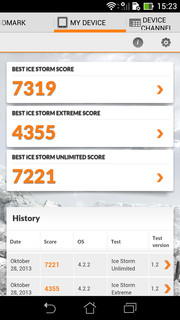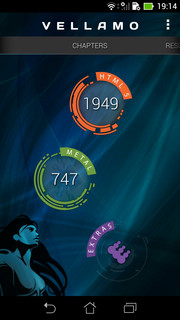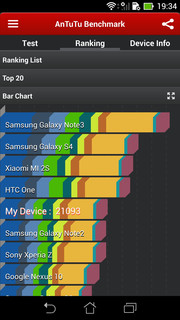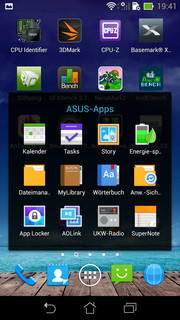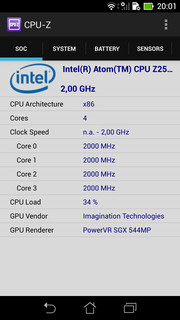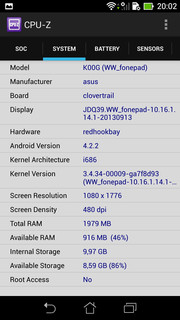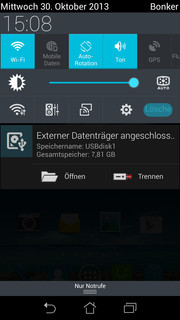Review Asus Fonepad Note FHD 6 Smartphone

For the original German review, see here.
Asus launched the first Fonepad on the market in April 2013 - according to the name and 7-inch size, a tablet for making calls. Consequently, we also tested it as a tablet. Now the Eee PC inventor goes a step further and introduced the Fonepad Note FHD 6 at the IFA. The idea to stuff everything in the name is certainly well meant, but it does sound a bit awkward. However, there are barely any open questions. The new Fonepad features a 6-inch screen with a Full HD resolution and a stylus. Due to its shrunken size of 6-inches, it now perfectly fits into the modern category of phablets and thus we classify it as a smartphone. It will, however, have to compete against its self-appointed rival, Samsung's Galaxy Note 2. The Fonepad will also have to face the Note 3 successor. Asus throws in the much bigger screen and the considerably lower price of 349 Euros (~$468, RRP) as buying arguments.
Like the first Fonepad and Memo Pad FHD 10, Asus again relies on an SoC (system-on-a-chip) from Intel for its newest scion. This time, the Atom Z2580 dual-core with a maximum clock of 2 GHz is installed. An Imagination PowerVR SGX 544MP2 with a clock rate of up to 533 MHz performs graphics calculations. The working memory is whole 2 GB and the internal storage of our review sample adds up to 16 GB. There are currently no bigger models available. However, a 32 GB model is already listed on the spec sheet. The storage can be expanded via a microSD card. The buyer can opt for the colors "Soft Charcoal Gray" or "Glaze White". HSPA+ is available but not LTE.
Case
Asus' Fonepad Note FHD 6 is not only the thickest phablet in our comparison field with almost 11 millimeters, but also the heaviest with 214 grams. The Galaxy Note 3 (8.3 mm, 168 g), the Xperia Z Ultra (6.5 mm, 212 g) and the Ascend Mate (9.9 mm, 200 g) are partly considerably slimmer. Nevertheless, the dimensions and weight of the review sample do not look over-sized; instead, they give the phablet a solid impression.
The 6-inch screen is covered by a scratch-resistant mineral glass that protects the input medium. Comparatively big stereo speakers dominate both the upper and lower areas. A metal frame encloses the entire front which gives the Note FHD 6 a quality look. The device's stiffness underpins this. It cannot be dented or warped anywhere and the phablet does not even produce a noise. Beyond that, the Fonepad proves to be absolutely pressure resistant.
The back is made of soft plastic that feels very pleasant. Although it is quite sleek, it is not slippery. The battery unfortunately cannot be removed, but the casing has enough room for a slot that accommodates a stylus. It merges nicely into the design when it is completely inserted and it sits tight so that there is no need to worry about losing the stylus.
Connectivity
The connectivity of Asus' Fonepad Note 6 is quite basic. The USB 2.0 port is used for both recharging and sharing data with a computer. MHL is not supported. Asus does not make any statements about USB-OTG either, but it worked perfectly.
The card reader is hidden below a flap on the side, directly beside the microSIM slot. It accepts microSD cards and supports SDXC formats up to 64 GB. A special feature is certainly the stylus that can be easily taken out of its slot.
Google's Android 4.2.2 Jelly Bean is used as the operating system. The modifications on the Fonepad 6 are mainly graphical and very subtle. Asus also includes a few of its own widgets and quite a few apps.
The program SuperNote is optimized for stylus inputting and easy to use. Good handwriting detection is achieved after a bit of practice, and handwritten notes are directly implemented in typescript. Single apps can be password-protected via the Locker app. Apart from that, two other useful tools are found in Splendid (color calibration) and AudioWizard (equalizer).
Bloatware is also unfortunately installed but remains within limits and can be deleted easily. The buyer additionally gets 5 GB of free Cloud storage.
Communication & GPS
Although Asus' Fonepad Note FHD 6 is almost as big as a small tablet, it is as versatile as a smartphone. The latter particularly offers a strong mobile communication connection and the phablet made in Taiwan does too. It supports quad-band GSM and can therefore be used in all language networks worldwide. A swift WCDMA/HSPA+ enables connecting to mobile data traffic (upload up to 5.76 MBit/s, download up to 42 MBit/s). There should not be any problems due to the broad frequency coverage.
The integrated Wi-Fi module supports the IEEE 802.11 a/b/g/n standards and transmits in both the 2.4 and 5.0 GHz frequency ranges. That sounds quite good considering the price range, although the latest ac standard is not available. The components' performance is rather middling in practical use. Although we were still connected at a distance of approximately 20 meters to the router (Fritz!Box 6360), opening a website took a long time. Bluetooth version 3.0 is on-board, but NFC (near field communication) is not installed.
The review sample sports both an A-GPS and a Glonass receiver for localization. However, the performance was not completely convincing. The site could not be determined indoors at all and it took a long time before we were correctly localized outdoors. The accuracy of the satellite connection was also unsatisfying. Our comparison test using a Garmin Edge 500 navigation system always showed a visible deviation from the driven route. The phablet was always a bit off route particularly in difficult tracking conditions, e.g. in the woods.
Telephony and Speech Quality
The speech quality is satisfactory, but not outstanding. As expected, the intelligibility is best when the large device is held to the cheek. Background noises are suppressed decently, but remain faintly audible. We always heard a background noise at our end. The speaker is quite useful, although the Fonepad user's voice distorts slightly and sounds like a radio to the partner. Calls made via the included headset are quite pleasant, and the called person could best be understood when using it. Unfortunately, we were not as intelligible on the other end when there were background noises because the microphone does not filter these noises.
Cameras & Multimedia
The Fonepad's webcam has a resolution of up to 1.2 megapixels (4:3; 1280x960 pixels). It is quite suitable for video calls and makes good recordings. However, pictures taken with this camera are too grainy so that detail-rich objects quickly deteriorate to a clump of pixels.
The primary camera on the back has a BSI sensor from Sony that has a resolution of 8 MP (3264x2448 pixels; 4:3). The fixed aperture with a guide number of f/2.0 enables decent photos even in low light. In fact, focused pictures are made although they are a bit too dark. Image noise remains within limits and will not bother most users, in particular when the pictures are viewed on the smartphone. However, the camera soon finds its limits when the lighting conditions get too difficult because it neither has an LED light nor a flash. This makes use in absolute darkness impossible.
Pictures taken in daylight are relatively decent. Asus installs a better sensor from Sony than the Japanese supplier builds into its own Xperia Z Ultra. The photos are mostly focused and are compelling. The colors look a bit too bright and a light yellowish cast is noticed on close-ups, making the pictures a bit too warm. The sensor quickly tends to overexpose in backlight and bright sunlight. Intense light overtaxes Sony's camera due to its large aperture. Nevertheless, the camera satisfied us on the whole, seeing that even considerably more expensive models do not feature better components.
Accessories and Warranty
The usual accessories are included for the Fonepad Note 6. In addition to an in-ear headset with various plugs, there is a brief instruction manual that is unfortunately only written in English. Apart from that, a modular power supply with an output of 7 watts (5.2 V; 1.35 A) and a matching USB cord are included.
A Side Flip Cover (from 24 Euros, ~$32) and a Bluetooth headset (EB50N) are optionally available. The latter even supports NFC, but the Fonepad regrettably does not and is not yet available in Europe.
Asus includes a 24 month warranty that cannot be upgraded.
Input Devices and Controls
The touchscreen of Asus' Fonepad Note FHD 6 has a size of 6-inches and exemplary gliding attributes. It detects up to ten inputs at the same time and implements them accurately. Screen rotations are also performed quickly.
The included stylus can also be used for inputting. A visible and acoustic signal indicates that the pen has been taken out of its slot. A warning sounds when the pen is not used for more than five minutes so that it is not forgotten. The app SuperNote opens as soon as the pen is taken out of the casing and notes can be jotted down right away. The stylus supports different levels of pressure so that it can be used for sketching. The cropping function enables snipping content and saving them as screenshots. Touchless scrolling through pages is also possible by holding the stylus on screen's edge.
As expected, the keyboard is generously sized and offers enough room and input area even in portrait mode. Only a little of the content is visible in landscape mode, but the keys are bigger. There is consequently no reason for complaining about handling. The Fonepad Note 6 does a really good job. Even a mouse connected via USB was identified without problems.
Display
The 6-inch screen of Asus' Fonepad Note 6 has a Full HD resolution of 1920x1080 pixels. That corresponds to an aspect ratio of 16:9 and a pixel density of 367 ppi. The Taiwanese manufacturer relies on Super IPS+ screen technology. Seen purely subjectively, the screen is a real eye-catcher and shines with its high brightness and rich colors.
Our assessments confirm the good impression. The screen gleams with an average of 461 cd/m² and is homogeneously illuminated with 88%. Those are very good rates comparatively that not even the high-priced competition in the form of Samsung (342 cd/m², 81%) or Sony (442 cd/m², 81%) achieves.
| |||||||||||||||||||||||||
Brightness Distribution: 88 %
Center on Battery: 469 cd/m²
Contrast: 1020:1 (Black: 0.46 cd/m²)
ΔE ColorChecker Calman: 4.8 | ∀{0.5-29.43 Ø4.78}
ΔE Greyscale Calman: 4.04 | ∀{0.09-98 Ø5}
Gamma: 2.63
CCT: 7421 K
The black value of 0.46 cd/m² is within a good range in view of the screen's brightness. Neither the Z Ultra (0.75 cd/m²/585:1) nor the Ascend Mate (0.6 cd/m²/825:1), which both have similarly bright screens, quite achieve this and thus the contenders cannot render a really deep black. The review sample is considerably more compelling in this point. The Fonepad's resulting contrast of 1020:1 is even very good.
A good job has also been done with the screen's color calibration. There are barely any visible deviations. Only the red hues exhibit a marginally increased DeltaE and look a bit darker. A slight greenish cast can be seen in the grayscale, but that will not be noticed in everyday use.
Outdoor use is not really a big challenge for the Fonepad Note 6. The phablet benefits from its high brightness and good contrast ratio. Only the reflective surface makes reading content difficult in direct sunlight. The device easily copes with bright surroundings or even dimmer lighting conditions.
The underlying Super IPS+ technology enables excellent viewing angle stability and barely leaves anything to be desired. Only hinted color deviations occur in extreme viewing angles. Solely the reflective surface could make viewing from the sides difficult in bright ambient light.
Performance
Asus' Fonepad Note FHD 6 uses an Intel Atom Z2580 as a processor. It features two cores and can process up to four threads simultaneously. The clock speed ranges from 1300 and 2000 MHz. The SoC is supported by 2 GB working memory. An integrated PowerVR SGX544MP2 takes care of graphics calculations.
The review sample clearly lags behind in the comparison field. Particularly the graphics performance is much too weak. Currently, this will be at most only an issue in sophisticated 3D games, but Asus' phablet does not convey a future-oriented impression with that. Minor stuttering was rare while using Android. The Fonepad also coped easily with playing movies in the screen's native resolution.
| AnTuTu v4 - Total Score (sort by value) | |
| Asus Fonepad Note FHD 6 ME560CG (K00G) | |
| Asus Fonepad ME372CG | |
| Samsung Galaxy Note 3 SM-N9005 | |
| Sony Xperia Z Ultra | |
| GFXBench (DX / GLBenchmark) 2.7 | |
| T-Rex Onscreen (sort by value) | |
| Asus Fonepad Note FHD 6 ME560CG (K00G) | |
| Huawei Ascend Mate | |
| Asus Fonepad ME372CG | |
| Samsung Galaxy Note 3 SM-N9005 | |
| Sony Xperia Z Ultra | |
| 1920x1080 T-Rex Offscreen (sort by value) | |
| Asus Fonepad Note FHD 6 ME560CG (K00G) | |
| Huawei Ascend Mate | |
| Asus Fonepad ME372CG | |
| Samsung Galaxy Note 3 SM-N9005 | |
| Sony Xperia Z Ultra | |
| Geekbench 3 | |
| 32 Bit Single-Core Score (sort by value) | |
| Asus Fonepad Note FHD 6 ME560CG (K00G) | |
| Asus Fonepad ME372CG | |
| Samsung Galaxy Note 3 SM-N9005 | |
| Sony Xperia Z Ultra | |
| 32 Bit Multi-Core Score (sort by value) | |
| Asus Fonepad Note FHD 6 ME560CG (K00G) | |
| Asus Fonepad ME372CG | |
| Samsung Galaxy Note 3 SM-N9005 | |
| Sony Xperia Z Ultra | |
| Geekbench 2 - 32 Bit - Total Score (sort by value) | |
| Asus Fonepad Note FHD 6 ME560CG (K00G) | |
| Huawei Ascend Mate | |
| Samsung Galaxy Note II GT-N7100 | |
| Samsung Galaxy Note 3 SM-N9005 | |
| Sony Xperia Z Ultra | |
| PassMark PerformanceTest Mobile V1 - System (sort by value) | |
| Asus Fonepad Note FHD 6 ME560CG (K00G) | |
| Huawei Ascend Mate | |
| Asus Fonepad ME372CG | |
| Samsung Galaxy Note 3 SM-N9005 | |
| Sony Xperia Z Ultra | |
Internet browsing should be a specialty of phablets. We in fact did not notice any shortcomings in practical use. Websites were displayed quickly and correctly in Google Chrome 30. The benchmark results are also quite decent and outline the expected impression. The Note 3 and Xperia Z Ultra are consistently faster, which is no surprise in view of their stronger SoC.
| Peacekeeper - --- (sort by value) | |
| Asus Fonepad Note FHD 6 ME560CG (K00G) | |
| Huawei Ascend Mate | |
| Asus Fonepad ME372CG | |
| Sony Xperia Z Ultra | |
| Samsung Galaxy Note 3 SM-N9005 | |
| Octane V1 - Total Score (sort by value) | |
| Asus Fonepad Note FHD 6 ME560CG (K00G) | |
| Huawei Ascend Mate | |
| Asus Fonepad ME372CG | |
| Sony Xperia Z Ultra | |
| Samsung Galaxy Note 3 SM-N9005 | |
| Mozilla Kraken 1.1 - Total (sort by value) | |
| Asus Fonepad Note FHD 6 ME560CG (K00G) | |
| Asus Fonepad ME372CG | |
| Sony Xperia Z Ultra | |
| Samsung Galaxy Note 3 SM-N9005 | |
* ... smaller is better
Asus' Fonepad Note 6 has 16 GB of internal storage. The user has roughly 9.5 GB available after initial use. The storage can be expanded via a microSD slot that supports memory cards with up to 64 GB (SDXC).
The installed flash memory's speed is middling. The high-priced competition from Samsung and Sony are much faster particularly in reading and writing small files. Generally speaking, the South Korean manufacturers are in a league of their own in this field.
| PassMark PerformanceTest Mobile V1 - Disk Tests (sort by value) | |
| Asus Fonepad Note FHD 6 ME560CG (K00G) | |
| Asus Fonepad ME372CG | |
| Huawei Ascend Mate | |
| Sony Xperia Z Ultra | |
| Samsung Galaxy Note 3 SM-N9005 | |
Games
The gaming power of the PowerVR SGX544MP2 graphics unit is not particularly good. Although the available performance is enough for most current games, the GPU finds its limits in 3D games with more sophisticated textures. The user will have to reckon with stutters here. Casual games, such as Angry Birds, can be played smoothly.
Emissions
Temperature
The temperature development of Asus' Fonepad Note 6 is on an uncritical level and close to the competition from Sony and Samsung. The phablet achieves a peak rate of 31.9 °C in idle operation. Only the Ascend Mate (max. 36.2 °C) is much warmer in the comparison field.
The temperatures increase up to 38.4 °C during load. The review sample thus produces considerably less waste heat than the competition. Again, Huawei's phablet (max. 47.8 °C) is clearly the device with the highest temperature.
(+) The maximum temperature on the upper side is 38.4 °C / 101 F, compared to the average of 35.2 °C / 95 F, ranging from 21.9 to 247 °C for the class Smartphone.
(+) The bottom heats up to a maximum of 36.1 °C / 97 F, compared to the average of 34 °C / 93 F
(+) In idle usage, the average temperature for the upper side is 30.1 °C / 86 F, compared to the device average of 32.9 °C / 91 F.
Speakers
Both stereo speakers are placed ideally for movie playback and have been optimized with Asus' well-known Sonic Master Technology. Their sound is quite compelling as long as the volume is not turned up to maximum. This could lead to a slightly muffled sound in treble-heavy sequences. Apart from that, the sound is really good; decent results can be achieved in particular when the user takes the trouble to use the equalizer.
Sound output via the stereo jack is also very satisfactory.
Energy Management
Power Consumption
The Fonepad Note 6's bright screen takes its toll on power consumption. The phablet consumes between 0.8 and 2.1 watts only in idle mode. Samsung's Galaxy Note 3 (0.3 - 1.4 watts) is much more energy-efficient here.
The consumption rates climb up to 6.8 watts in load. This rate is ascertained in maximum screen brightness and CPU plus GPU load via the Stability Test app. The Fonepad is only slightly above the Note 3 (max. 6.5 watts) and Xperia Z Ultra (max. 6.1 watts) here. The comparatively weak GPU compensates for the bright screen's power consumption in this case. The standby consumption of 0.4 watts is a bit too high.
| Off / Standby | |
| Idle | |
| Load |
|
Key:
min: | |
Battery Runtime
The battery in the Fonepad Note 6 supplies 3200 mAh and has a similar capacity as the competition. Only Huawei's Ascend Mate sports a much bigger battery (4050 mAh). The devices runtime is quite good despite the somewhat higher power consumption. However, it cannot compete with those of the contenders.
We ascertained the maximum runtime using minimum screen brightness and only Wi-Fi on. An online script simulated reading a text. The review sample lasted almost 15 hours in this scenario.
The minimum runtime was ascertained using the Stability Test app and maximum screen brightness, and all communication modules enabled for this. The device shut down after only 2 hours and 40 minutes.
The Wi-Fi browsing test is more realistic. A website medley opened every 40 seconds in a brightness setting of 150 cd/m². The phablet turned itself off after exactly nine and a half hours. Although this is a low rate compared with the Note 3 (18 hours), the power will be enough to survive a day. The battery cannot be removed.
Verdict
Asus' Fonepad Note FHD 6 is a very good phablet, although compromises have to be made compared with premium models. The high-definition touchscreen is certainly the highlight and can also be used with a stylus. It is not only a tool, but has good multimedia features as well. Besides that, the camera is quite compelling.
Nevertheless, a few things are not available. In addition to the high-speed Wi-Fi ac standard, there is no LTE, MHL or NFC. The installed Intel Atom SoC also clearly lags behind the high-end devices with a Snapdragon 800 in terms of performance. However, it supplies a good performance. The Fonepad therefore primarily owes its good rating to its unrivaled price-performance ratio with an RRP of 349 Euros (~$468).
The podium contenders from Samsung (749 Euros, ~$1004) and Sony (799 Euros, ~$1071) are twice as expensive. Even the equally affordable Huawei Ascend Mate (RRP 400 Euros, ~$536; currently approx. 300 Euros, ~$402) cannot compete with that. The phablet made in China only offers an HD resolution, single-band Wi-Fi and a much poorer camera. Thus, users who are looking for a good phablet and do not want to invest vast sums of money should grab the Asus Fonepad Note 6. The price of Samsung's Galaxy Note 2 has also been reduced considerably since the launch of its successor and is a real alternative to the Fonepad.




